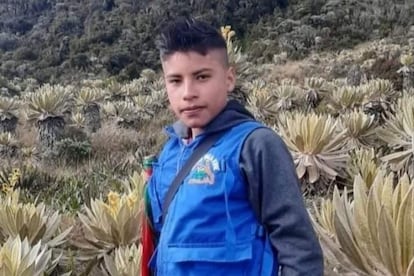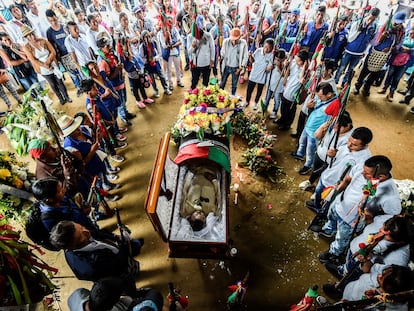Fourteen-year-old environmentalist shot dead in Colombia
The death of Breiner David Cucuñame, killed during an attack against the Indigenous Guard, has shone a spotlight on the dangers faced by activists in the country


The murder of social leaders, in particular environmental activists, continues unchecked in Colombia. The most recent victim is Breiner David Cucuñame, a 14-year-old who was killed while on patrol with the Guardía Indígena, or Indigenous Guard, an organization formed by men, women and children that seeks to protect indigenous communities and land.
Although the motive for his killing has not been officially confirmed, he could be considered to be the first fatal victim of violence against environmentalists in 2022 in Colombia, which is the most dangerous place in the world for environmental activists. His death in Colombia’s conflict-ridden Cauca department has shaken up the country and shone a spotlight on the extreme vulnerability of young indigenous activists in communities caught in the crossfire of illegal armed groups.
In a photo used by the National Parks of Colombia Service to lament Cucuñame’s death, the 14-year-old is seen in his Indigenous Guard green vest, with a staff – a symbol of authority in the group – by his side. The United Nations High Commissioner for Human Rights in Colombia has denounced the attack on the Indigenous Guard, which took place on January 14 and also claimed the life of another person in the locality of Buenos Aires.
Indigenous authorities blame the attack on a group of dissidents from the now-defunct Revolutionary Armed Forces of Colombia (FARC), which disbanded five years ago following a peace agreement with the government. In a statement to condemn Cucuñame’s killing, the Regional Indigenous Council of Cauca (CRIC) described the 14-year-old as a “carer of Mother Earth” and a “child protector of life” who wanted his indigenous community of Nasa to be uplifted by “collective action and big dreams.”
Colombian President Iván Duque also expressed his condolences. “The death of young Breiner David Cucuñame, a defender of environmental protection in his community in Cauca, fills us with sadness,” he wrote in a message on social media, which also called on the public prosecution to clarify what happened.
The attack on January 14 took place in a rural area in the north of Cauca, while the Indigenous Guard was trying to secure the territory after receiving reports about the presence of armed men in the preserve. When they got to the area, the dissidents fired at the Indigenous Guard and at the community, according to the North Cauca Association of Indigenous Reserves (ACIN). During the shootout, Guillermo Chicame, a member of the Indigenous Guard’s security team, was killed, while Fabián Camayo, a leader in the group, was injured. The shooting continued and soon after the young Cucuñame – who according to witnesses had been accompanying his father after a long day at work – was shot dead.
The death of young Breiner David Cucuñame, a defender of environmental protection in his community in Cauca, fills us with sadnessColombian President Iván Duque
The Indigenous Guard is usually made up of unarmed men and women who carry a staff to indicate their authority. In other times, armed groups respected them. However, in the midst of the growing fragmentation that characterizes the security crisis in Colombia, both indigenous governors and members of the Indigenous Guard have been killed, and their names added to the long list of assassinated social leaders. At least 78 human rights defenders were killed in 2021, according to the UN Human Rights Office, with most murders recorded in Cauca. The public ombudsman has an even higher toll, recording 145 deaths last year.
The north of Cauca, where most of the Nasa community lives, borders the southern Cauca Valley and is a corridor for drug traffickers looking to get their product to the Pacific. This has turned the area into a powder keg, with illegal groups, including FARC dissidents and the National Liberation Army (ELN) guerrilla group, operating alongside drug trafficking organizations. Mexican cartels have even been reported there.
Adding to the deadly legacy of drug trafficking and armed conflict is the danger of defending the environment in Colombia, which was named the most dangerous country in the world for environmental activists by the human rights NGO Global Witness two years in a row. Of the 227 murders of environmentalists recorded worldwide in 2020, 65 took place in the South American country. In its most recent 2021 report, Global Witness warned that indigenous communities are most affected by the violence.
Young people in Colombia have also been caught in the crossfire. Last weekend, the killing of a 10-year-old girl shocked the country. Valeria Murillo died on Sunday after being hit by a stray bullet that went through the wooden wall of her house in the Medio San Juan municipality, located in the Chocó department on the Pacific border. She was hiding inside with her mother after members of the drug cartel The Gulf Clan began firing indiscriminately at the area.
“We are making an emphatic call to respect the life and integrity of the civilian population, especially boy, girls and teenagers,” the UN Human Rights Office in Colombia wrote in a message on Twitter to condemn the attack.
Tu suscripción se está usando en otro dispositivo
¿Quieres añadir otro usuario a tu suscripción?
Si continúas leyendo en este dispositivo, no se podrá leer en el otro.
FlechaTu suscripción se está usando en otro dispositivo y solo puedes acceder a EL PAÍS desde un dispositivo a la vez.
Si quieres compartir tu cuenta, cambia tu suscripción a la modalidad Premium, así podrás añadir otro usuario. Cada uno accederá con su propia cuenta de email, lo que os permitirá personalizar vuestra experiencia en EL PAÍS.
¿Tienes una suscripción de empresa? Accede aquí para contratar más cuentas.
En el caso de no saber quién está usando tu cuenta, te recomendamos cambiar tu contraseña aquí.
Si decides continuar compartiendo tu cuenta, este mensaje se mostrará en tu dispositivo y en el de la otra persona que está usando tu cuenta de forma indefinida, afectando a tu experiencia de lectura. Puedes consultar aquí los términos y condiciones de la suscripción digital.
More information
Archived In
Últimas noticias
Most viewed
- Alain Aspect, Nobel laureate in physics: ‘Einstein was so smart that he would have had to recognize quantum entanglement’
- Mexico’s missing people crisis casts a shadow over World Cup venue
- Why oil has been at the center of Venezuela-US conflicts for decades
- Trump clarifies who is ultimately in charge in Venezuela: ‘Me’
- Mexico seeks to shore up its defenses following US incursion in Venezuela









































